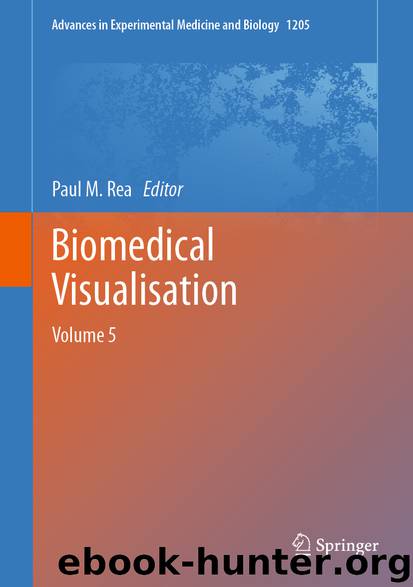Biomedical Visualisation by Paul M. Rea

Author:Paul M. Rea
Language: eng
Format: epub
ISBN: 9783030319045
Publisher: Springer International Publishing
(3)Physical access: The fragility of material must be fully understood before contact with these ‘objects’ is permitted. There may also be concerns regarding damage and loss of irreplaceable ‘objects’.
4.1 Intellectual Access, Medical Humanities
When working to contextualise ‘objects’ and images relating to this session, it is important to consider the different learning styles and cultural backgrounds of the audience, as the resources we have chosen for the proposed lesson relate predominantly to European medicine. To make this lesson accessible to audiences and learners from around the world, it is important to establish a starting point of knowledge and provide a comprehensive, but brief, history of European medicine and anatomical art, including relevant ethical concerns. The historical anatomical context from this chapter can be adapted accordingly to suit the learning needs of your audience. Thinking ahead to how this introduction will impact on the development of observational skills and discussion, it is important that learners understand the environments and era when this type of anatomical/medical art was created along with the legal and moral codes of practice. Therefore, it is advisable to begin this lesson by delivering key points of information relating to the history of dissection and the legal acts surrounding the procurement of bodies from 1505 to 2004. Provision of unbiased historical information will enable learners to appreciate each ‘object’ within each time period allowing them to formulate their own thoughts and emotions.
To balance the introduction, you can also introduce your audience to the concept of the sourcing of human remains for medical research and art through four points in a historical timeline, including the moments in time when bodies were sourced without formal consent processes and dissection was perceived as punitive or discriminatory (Patrizio and Kemp 2006). This means demonstrating how law had disproportionately affected those seen as ‘lower class’ with limited access to legal defence and at most risk of offending or ill health due to impoverished circumstances and living in areas of higher risk behaviours (Bryant and Peck 2009). This introduction has to be provided, in a supportive and ‘safe’ teaching environment, with the cultural background of the audience in mind, sufficient reassurance that learners vocalise their uneasiness at any point of the session, and that the experts are available for ‘emotional debriefing’ sessions at the end of the lesson.1505: The first dissection act in Scotland was the 1505 Seal of Cause granted to The Barber Surgeons of Edinburgh, later known as The Royal College of Surgeons of Edinburgh. In Edinburgh from 1505, the body of “ane condampnit man efter he be deid”. In England, from 1540, four bodies a year were granted to the Company of Barber-Surgeons, later known as the Royal College of Surgeons of England (Patrizio and Kemp 2006).
Download
This site does not store any files on its server. We only index and link to content provided by other sites. Please contact the content providers to delete copyright contents if any and email us, we'll remove relevant links or contents immediately.
Algorithms of the Intelligent Web by Haralambos Marmanis;Dmitry Babenko(8522)
Test-Driven Development with Java by Alan Mellor(7404)
Data Augmentation with Python by Duc Haba(7299)
Principles of Data Fabric by Sonia Mezzetta(7048)
Learn Blender Simulations the Right Way by Stephen Pearson(6984)
Microservices with Spring Boot 3 and Spring Cloud by Magnus Larsson(6802)
RPA Solution Architect's Handbook by Sachin Sahgal(6216)
Hadoop in Practice by Alex Holmes(6031)
The Infinite Retina by Robert Scoble Irena Cronin(5914)
Jquery UI in Action : Master the concepts Of Jquery UI: A Step By Step Approach by ANMOL GOYAL(5873)
Big Data Analysis with Python by Ivan Marin(5720)
Life 3.0: Being Human in the Age of Artificial Intelligence by Tegmark Max(5402)
Pretrain Vision and Large Language Models in Python by Emily Webber(4683)
Infrastructure as Code for Beginners by Russ McKendrick(4462)
WordPress Plugin Development Cookbook by Yannick Lefebvre(4195)
Functional Programming in JavaScript by Mantyla Dan(4124)
The Age of Surveillance Capitalism by Shoshana Zuboff(4116)
Embracing Microservices Design by Ovais Mehboob Ahmed Khan Nabil Siddiqui and Timothy Oleson(3981)
Applied Machine Learning for Healthcare and Life Sciences Using AWS by Ujjwal Ratan(3958)
